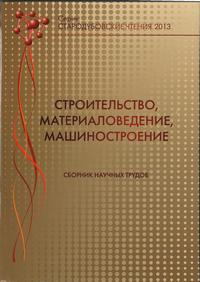A study of the mechanical properties, structure and phase composition of materials based on cement composites and carbon nanotubes, depending on the concentration and surface functionalization
Keywords:
Issledovanie, cement, Concentration, Functionalization.Abstract
The optimum concentrations of the carbon nanomodifier in the composition of the cement composite are determined, at which the maximum strength characteristics of the resulting material are observed. The effect of surface functionalization of CNTs on the hydration processes of cement clinker was studied. X-ray diffractometry and scanning electron microscopy have been used to study changes in the phase composition and structure when introducing concrete, both pure and functionalized CNTs, into the volume of concrete.References
Раков Э.Г. Химия и применение углеродных нанотрубок // Успехи химии. – 2001. № 10. с. 934-937. 2. Florence Sanchez, Chantal Ince. Microstructure and macroscopic properties of hybrid carbon nanofiber/silica fume cement composites. Composites Science and Technology Vol. 69 (2009) 1310–1318. 3. Яковлев Г.И., Первушин Г.Н., Корженко А., Бурьянов А.Ф., Пудов И.А., Лушникова А.А. Модификация цементных бетонов многослойными углеродными нанотрубками // Строит. материалы. – г. Москва 2011. № 2. С. 47-51. 4. Петрунин С.Ю., Попов М.Ю., Ваганов В.Е., Решетняк В.В., Закревская Л.В. Опыт применения тубулярных углеродных наноструктур в строительных материалах. // Нанотехнологии в строительстве: научный Интернет-журнал. М.: ЦНТ «НаноСтроительство». 2012. № 5. С. 65–80. URL: http // www.nanobuild.ru. 5. Li G.Y. Wang P.M., Zhao X. Mechanical behavior and microstructure of cement composites incorporating surface-treated multi-walled carbon nanotubes. Carbon. (2005). № 43. pp. 1239-1245. 6. Li G.Y., Wang P.M., Zhao X. Pressure-sensitive and microstructure of carbon nanotube reinforced cement composites. Cement and Concrete Research. 2007. Vol. 29. pp. 377-38. 7. Кашкина Л.В., Стебелева О.П., Петраковская Э.А., Баюкова О.А. Влияние гидродинамической кавитации на структуру и свойства сажевых частиц. Тезисы докладов на 8-мую Международную конференцию «Углерод: фундаментальные проблемы науки, материаловедение, технология». Троицк 25-28 сентября 2012 г. / Сборник материалов, С. 244-245. 8. Петрунин С.Ю., Закревская Л.В., Ваганов В.Е. Влияние наноразмерного модификатора на прочность цементного композита. Строительство, материаловедение, машиностроение: Сб. науч. трудов. Вып. 64 – Дн-вск., ПГАСА, 2012, С. 35-39. 9. Осипов Н.Н., Клюев М.В., Разумов А.А., Наумов А.Г., Скворцов К.В, Хорьков К.С. Химическая модификация углеродных нанотрубок // Известия высших учебных заведений: Химия и хим. технология 2013, Т. 56, №. 1 Стр. 100-103
Downloads
Published
Issue
Section
License
Редакція Видання категорично засуджує прояви плагіату в статтях та вживає всіх можливих заходів для його недопущення. Плагіат розглядається як форма порушення авторських прав і наукової етики.
При виявлені у статті більш ніж 25% запозиченого тексту без відповідних посилань та використання лапок, стаття кваліфікується як така, що містить плагіат. У цьому випадку стаття більше не розглядається редакцією, а автор отримує перше попередження.
Автори, в статтях яких повторно виявлено плагіат, не зможуть публікуватися в усіх журналах Видавництва ДВНЗ «Придніпровська державна академія будівництва та архітектури».
Автори, які публікуються у цьому журналі, погоджуються з наступними умовами:
- Автори залишають за собою право на авторство своєї роботи та передають журналу право першої публікації цієї роботи на умовах ліцензії Creative Commons Attribution License, котра дозволяє іншим особам вільно розповсюджувати опубліковану роботу з обов'язковим посиланням на авторів оригінальної роботи та першу публікацію роботи у цьому журналі.
- Автори мають право укладати самостійні додаткові угоди щодо неексклюзивного розповсюдження роботи у тому вигляді, в якому вона була опублікована цим журналом (наприклад, розміщувати роботу в електронному сховищі установи або публікувати у складі монографії), за умови збереження посилання на першу публікацію роботи у цьому журналі.
- Політика журналу дозволяє і заохочує розміщення авторами в мережі Інтернет (наприклад, у сховищах установ або на особистих веб-сайтах) рукопису роботи, як до подання цього рукопису до редакції, так і під час його редакційного опрацювання, оскільки це сприяє виникненню продуктивної наукової дискусії та позитивно позначається на оперативності та динаміці цитування опублікованої роботи (див. The Effect of Open Access).

